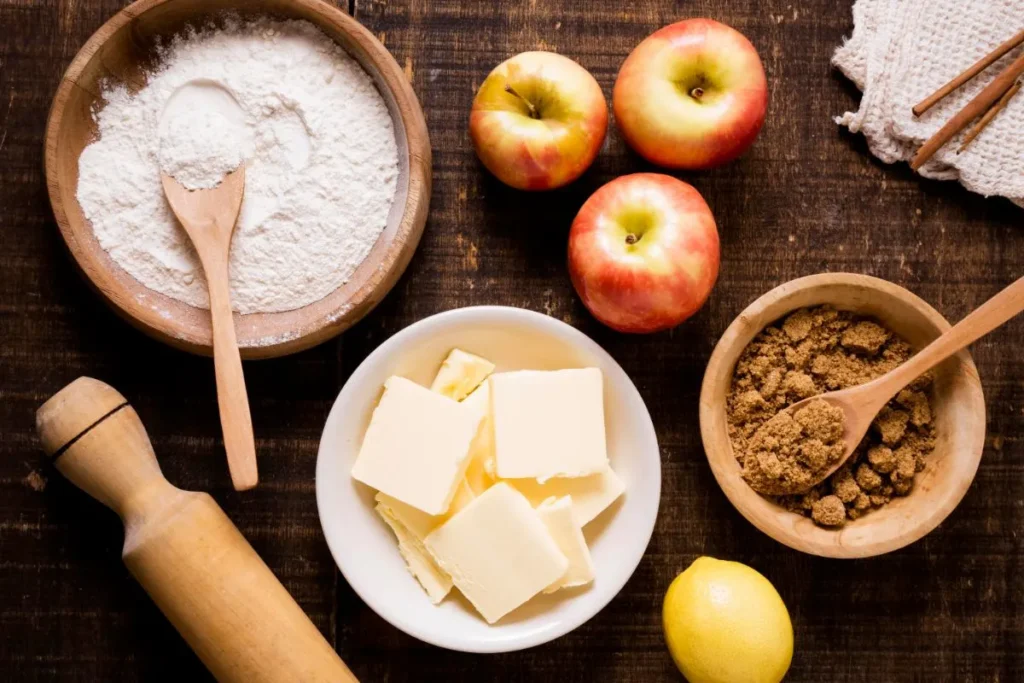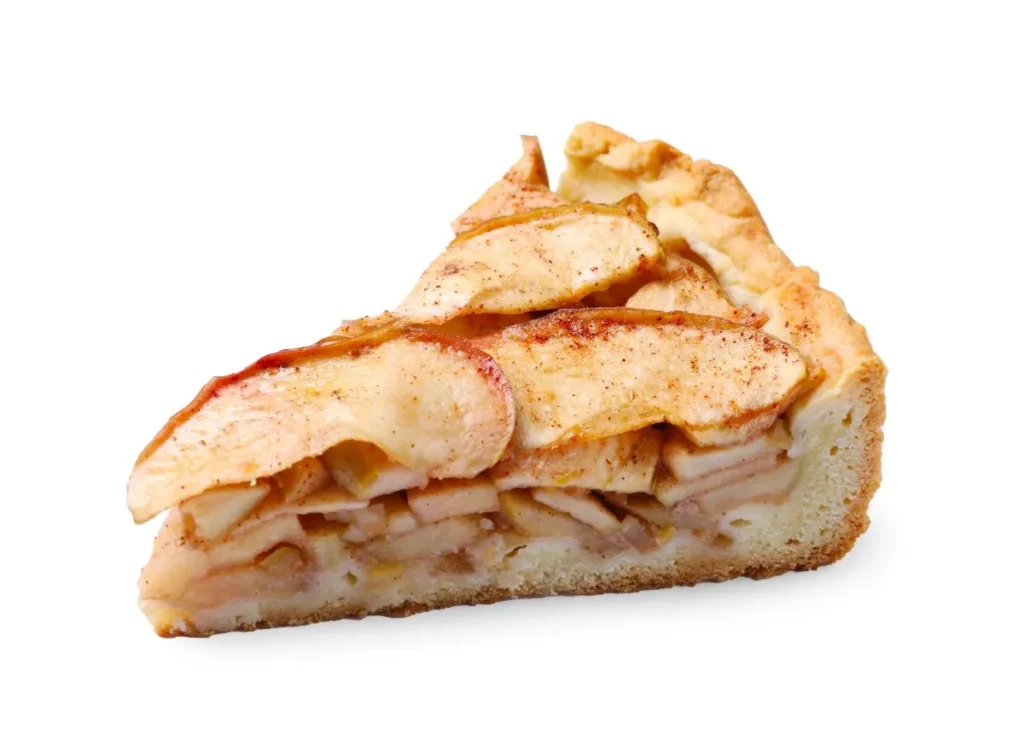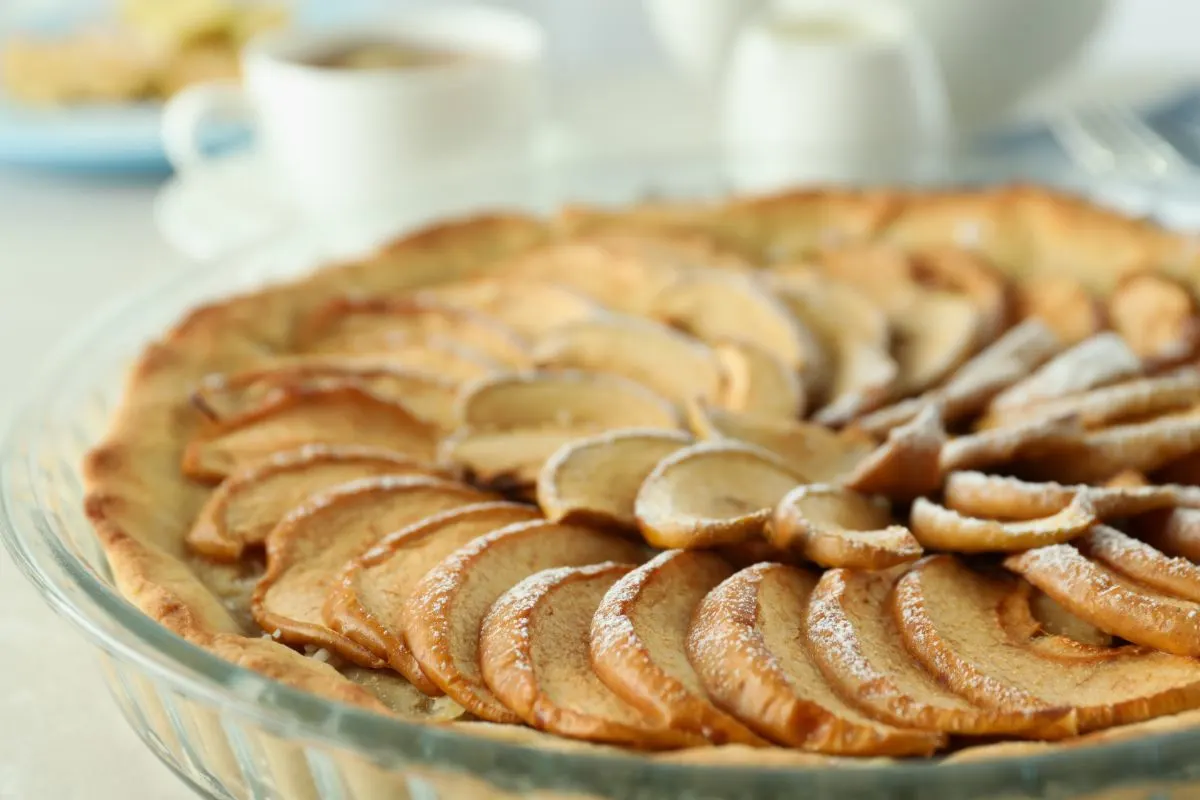This French apple pie article explores its origins, ingredients, baking tips, and unique twists. Discover how to make a flaky crust, perfect filling, and serve it with style.
Introduction
French apple pie, often inspired by the renowned French baking tradition, is a delightful dessert that highlights the elegance and warmth of simple, fresh ingredients. Although this treat shares similarities with other well-known apple pies, it has its own distinct character. The French approach emphasizes a buttery pastry, carefully chosen apples, and sometimes a creamy custard or delicate frangipane layer. As you savor each bite, you will notice subtle differences in texture, aroma, and flavor that set this dessert apart from its American, English, and Dutch counterparts.
However, understanding and preparing a proper French apple pie involves much more than tossing apples into a crust. In fact, every step—from selecting the right apples, to assembling the filling, to baking at the ideal temperature—plays a key role in achieving a flawless result. This comprehensive guide will help you master every detail. Therefore, whether you are a seasoned baker looking to refine your technique or a beginner hoping to impress your family, you will find plenty of valuable insights here.
In addition, you will learn how to prepare a crisp, flaky crust, balance sweet and tart flavors, and experiment with fillings that celebrate the apples’ natural goodness. Furthermore, we will discuss variations that you can try, as well as serving suggestions, storage tips, and answers to common questions. By the end of this article, you will feel confident in crafting your own French apple pie that not only looks stunning but also tastes extraordinary.
- Introduction
- What Sets French Apple Pie Apart
- Choosing the Perfect Apples
- Essential Ingredients and Equipment
- Mastering the Crust
- Building the Filling
- Step-by-Step French Apple Pie Recipe
- Exploring Variations and Innovations
- Pairing Suggestions
- Serving, Storing, and Reheating
- Nutritional Information
- Frequently Asked Questions (FAQ)
- Internal Linking
- Conclusion
What Sets French Apple Pie Apart
Historical Background and Cultural Roots
French apple desserts have deep roots. While American apple pies often focus on chunky fillings and double crusts, French versions reflect centuries-old patisserie techniques. For example, French bakers traditionally value presentation, thinly sliced apples, and rich textures. Moreover, many French apple pies highlight tender apples arranged in neat patterns and sometimes include a thin layer of custard or almond cream.
Key Differences in Taste and Texture
In contrast to the denser fillings of many American apple pies, French apple pies often feel lighter. This is because they frequently call for sautéed or gently cooked apples that retain a delicate structure. In addition, the filling may feature a smoother, more refined consistency, using subtle spices that never overpower the fruit’s natural flavor. Therefore, if you love a dessert that looks like a piece of art and boasts a refined taste, this style is perfect for you.
Choosing the Perfect Apples
Flavor Profiles of Classic Apples
Selecting the right apples is crucial. Traditionally, French varieties like Reinette or Calville Blanc are admired for their fragrance and balanced tartness. However, these might not be readily available in the U.S.
Suitable U.S. Substitutions
In the U.S., Granny Smith apples are a popular choice due to their tartness and firm structure. Honeycrisp, Golden Delicious, and Braeburn can also work well. Furthermore, combining sweet and tart apples creates a more complex flavor. For example, mix Granny Smith with Honeycrisp to achieve a balance that echoes the complexity of a traditional French dessert.
Balancing Sweetness and Tartness
To get the best results, taste your apples first. If they are very sweet, you might reduce added sugar. Conversely, if they are too tart, add a little more sweetness. This approach ensures your pie remains well-balanced, which is one of the hallmarks of French pastry.
Essential Ingredients and Equipment
Pastry Dough Components
A perfect French apple pie starts with an excellent crust. Use high-quality butter, all-purpose flour, a small amount of sugar, and a pinch of salt. Moreover, keep your butter cold, as this helps create the flaky layers that define a superb crust.
Essential Baking Tools
Have a rolling pin, a sharp paring knife for slicing apples, a 9-inch pie dish, a pastry brush for glazing, and a silicone mat on hand. In addition, consider using pie weights or dried beans if you choose to blind-bake your crust. Therefore, investing in the right tools makes your baking experience smoother.
Enhancing Flavor with Spices and Extracts
Cinnamon, nutmeg, and vanilla extract are classic additions. They should accent, not overshadow, your apples. Therefore, add these spices gradually. In addition, feel free to include a hint of lemon zest for brightness. Always taste as you go to ensure a balanced profile.
Mastering the Crust
Techniques for a Flaky, Buttery Crust
To achieve a crust worthy of a French patisserie, work swiftly and gently. First, cut butter into the flour until it resembles coarse meal. Then, add ice-cold water spoon by spoon. However, do not overwork the dough. Once it holds together, shape it into a disk, wrap it, and chill it. Chilling allows the gluten to relax and the butter to firm up, resulting in a tender, flaky crust.
Blind-Baking and Pre-Baking
For French apple pies with custard or cream layers, blind-baking the crust helps prevent sogginess. Line the crust with parchment paper and fill it with pie weights. Bake until slightly firm before adding fillings. Consequently, the crust stays crisp throughout the baking process.
Troubleshooting Common Crust Issues
If your dough cracks, you may have added too little water. If it shrinks, you might have overworked it or skipped resting. However, do not worry. With practice, these problems become easy to fix. Simply adjust the moisture next time or chill the dough longer.
Building the Filling
Pre-Cooking vs. Fresh Apples
Some French apple pie recipes suggest gently cooking apples before adding them to the crust. This concentrates their flavor and helps control moisture. Conversely, using fresh slices gives a firmer texture. Try both methods to determine which you prefer. For many bakers, pre-cooking apples leads to a smoother, more cohesive filling.
Proper Seasoning with Spices
Add cinnamon and nutmeg sparingly. However, do not hesitate to include a hint of vanilla extract for aromatic depth. The goal is to highlight the apples, not mask them. In addition, a small pinch of salt can brighten the overall flavor.
Achieving the Right Consistency
If your filling seems too watery, stir in a bit of cornstarch. This thickener binds the juices without affecting the flavor. Moreover, allow the filling to cool slightly before assembling the pie. Therefore, the final result will have a perfect balance between softness and structure.
Adjusting Sweetness and Acidity
Taste your filling before baking. If it seems too sweet, add a touch of lemon juice. Conversely, if it is too tart, add a little more sugar. Remember, the flavor should be subtle and balanced, which is a signature of French desserts.
Step-by-Step French Apple Pie Recipe

Ingredients (Makes One 9-Inch Pie)
Crust:
- 2 1/2 cups all-purpose flour
- 1 cup (2 sticks) cold unsalted butter, diced
- 1 tablespoon granulated sugar
- 1 teaspoon salt
- 6-8 tablespoons ice water
Filling:
- 6 large apples (e.g., 3 Granny Smith + 3 Honeycrisp), peeled, cored, thinly sliced
- 1/3 cup granulated sugar (adjust to taste)
- 2 tablespoons brown sugar
- 1 teaspoon cinnamon
- 1/4 teaspoon nutmeg
- 1 teaspoon vanilla extract
- 1 tablespoon cornstarch (as needed)
- 1 tablespoon lemon juice (optional, for brightness)
Topping (Optional):
- 1 tablespoon granulated sugar
- 1/4 teaspoon cinnamon
Preparing the Crust
- In a large bowl, whisk the flour, sugar, and salt.
- Add cold butter cubes and use a pastry cutter or two forks to cut the butter into the flour until it resembles coarse meal.
- Add ice water, one tablespoon at a time, mixing gently until the dough just comes together.
- Shape the dough into two disks (one slightly larger for the bottom crust), wrap in plastic, and chill for at least 1 hour.
Making the Filling
- Combine sliced apples with sugars, cinnamon, nutmeg, and vanilla. Stir gently.
- Taste and adjust sugar as needed. If too juicy, add a little cornstarch. If too sweet, add lemon juice.
- Let the mixture sit for 10 minutes to allow flavors to meld.
Assembling the Pie
- Preheat your oven to 375°F (190°C).
- Roll out the larger dough disk on a lightly floured surface to about 1/8-inch thickness. Carefully place it into a 9-inch pie dish. Trim excess dough, leaving a slight overhang.
- If desired, blind-bake by lining the crust with parchment and using pie weights, then baking for 15 minutes until partially set. Remove weights and let it cool briefly.
- Spoon the apple filling into the crust.
- Roll out the second disk for the top crust. You can leave it whole or create a lattice pattern. Place it over the apples, seal the edges, and crimp decoratively.
- Brush the top crust with a little water and sprinkle with the cinnamon-sugar mixture.
- Cut small slits on the top crust to allow steam to escape.
Baking Times and Tips
- Bake at 375°F (190°C) for about 45-55 minutes or until the crust is golden and the filling is bubbly.
- If the crust browns too quickly, cover it loosely with foil.
- Let the pie cool on a wire rack for at least 2 hours before slicing. Cooling allows the filling to thicken.
Exploring Variations and Innovations
Adding Almond Cream (Frangipane)
For a luxurious twist, you can spread a thin layer of almond cream beneath the apples. This frangipane-like layer adds richness and depth. Therefore, you get a nutty flavor that complements the fruit perfectly.
Incorporating Dried Fruits or Nuts
Try adding chopped walnuts or dried cranberries to the filling. These ingredients provide crunch and extra flavor. In addition, feel free to reduce the spices slightly, so the new additions stand out.
Experimenting with Different Pastries
You can also switch up your crust. For instance, using a pâte sucrée results in a slightly sweeter, cookie-like base. Meanwhile, a puff pastry crust creates a lighter, crispier top. Therefore, feel free to be creative with your dough selection.
Pairing Suggestions
While French apple pie stands beautifully on its own, a modest dollop of whipped cream or a scoop of vanilla ice cream can enhance its creamy texture. In addition, a cup of coffee or a pot of mild tea is a lovely companion. Therefore, serve it as a dessert after a hearty meal to impress your guests.
Serving, Storing, and Reheating
Optimal Serving Temperature
Serve your French apple pie slightly warm. This temperature brings out the flavors of the apples and the buttery crust.
Proper Storage Methods
Cover leftover pie tightly and store in the refrigerator for up to three days. This ensures the fruit remains fresh. In addition, keep it in an airtight container to preserve the crust’s texture as much as possible.
Reheating Without Sacrificing Quality
To reheat, place a slice in a 350°F (175°C) oven for about 10 minutes. Avoid microwaving, as it can make the crust soggy. Thus, a gentle oven reheat keeps the pie crisp and aromatic.

Nutritional Information
Per 100g serving:
| Nutrient | Amount |
|---|---|
| Calories | ~220 kcal |
| Carbohydrates | ~30 g |
| Fiber | ~2 g |
| Sugars | ~15 g |
| Protein | ~2 g |
| Fat | ~10 g |
| Saturated Fat | ~6 g |
| Sodium | ~110 mg |
Values are approximate and depend on specific ingredients used.
Frequently Asked Questions (FAQ)
What is the difference between French apple pie and regular apple pie?
French apple pie often includes a more refined approach, using thinner, elegantly arranged apple slices and sometimes a creamy or custard layer. In contrast, a “regular” (often American) apple pie tends to feature chunkier apples, a double crust, and a heartier, more rustic feel.
What is French apple pie made of?
A French apple pie typically consists of a flaky butter crust, fresh sliced apples, a touch of sugar and spice, and occasionally an added layer of smooth custard or almond cream. The flavors are balanced, subtle, and delicate.
What is the difference between American apple pie and English apple pie?
American apple pie usually features a double crust, with thick slices of apple and a sweet, spiced filling. English apple pie often has a single crust on top with stewed apples inside and may be less sweet, highlighting the apple’s natural tang.
What is the difference between Dutch and apple pie?
A Dutch apple pie often includes a streusel topping of butter, sugar, and flour crumbled on top, rather than a traditional pastry lid. It may also contain a slightly softer apple filling. Apple pie, on the other hand, typically uses a full top crust or lattice pattern.
Internal Linking
For those who love experimenting in the kitchen, consider exploring other fruit-based treats or comparing various culinary techniques.
- Learn about different ways to use apples by checking out our Apple Pie Cinnamon Rolls page, an inventive twist on a classic roll.
- If you want to try more dessert ideas, our Pecan Pie Cheesecake recipe blends two American favorites for a rich and creamy treat.
- You can also explore savory recipes for inspiration and variety. For instance, if you enjoy comforting meals, discover how to add depth to a simple soup, such as in our 4 Ingredient Potato Soup.
Conclusion
In conclusion, a French apple pie is more than just a dessert. It is a testament to the artistry and elegance of French baking. By selecting the right apples, mastering a flaky crust, and balancing flavors, you can create a pie that is both visually appealing and incredibly delicious. Moreover, do not hesitate to experiment with variations, like adding almond cream or trying different types of pastry. Therefore, let this guide inspire you to embrace the subtle sophistication of French apple pie and enjoy a timeless treat that has captivated dessert lovers around the world.

